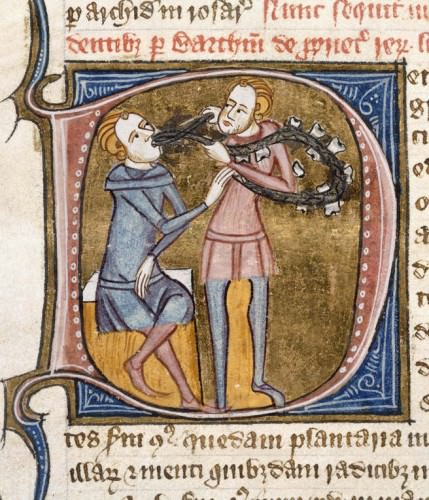In general, being a grandma, I tend to think that old ways are always the best. Medicine (including dentistry) is a definite exception. Medieval dentistry is something that most of us probably don't want to think about in any depth, but apparently there are those who do so. Some of the toothpaste recipes below are from a 2004 article in Nature by Trevor Anderson - the full article (PDF) is here, Here's an excerpt:
John of Gaddesden wrote the Rosa Anglica in Latin around 1314AD... John’s section on toothache includes many prayers and charms. He mentions that anyone who prays to St Apollonia (wiki) on her feast day (February 9th) will be cured of toothache. St Apollonia (d.c.249AD) was an elderly deaconess of Alexandria who was martyred by having all her teeth extracted and was then burnt alive.
One charm involved repeatedly drawing three vertical lines on parchment (to represent running water) while touching the painful tooth with one’s finger. He also mentions that, ‘some say that the beak of a magpie hung from the neck cures pain in the teeth’. Apparently, he is not convinced by this particular charm. He also states that you should prick a ‘many footed worm which rolls up in a ball when you touch it’, with a needle. You then touch the aching tooth with the same needle and, ‘the pain will be eased’. Obviously, a reference to pain transference from tooth worm to the worm-like centipede.
Other recipes are from The Trotula (wiki), a set of medieval texts on women's medicine.
Medievalists.net:
1. According to Gilbertus Anglicus’ Compendium of Medicine, it is important to rub your teeth and gums with a cloth after eating, because it is important to ensure that “no corrupte mater abyde amonge þe teeþ” (“no corrupt matter abides among the teeth,”) Anderson, p.421).
You can also munch on a paste of pepper and salt for that lovely scratchy feeling, and old-fashioned taste. Gilbertus advises, “chewe þid poudir a good while in [your] mooþ, and then swolle it down” (“chew this powder a good while in [your] mouth and then swallow it down”, Anderson, p.421). As a side benefit, you’re likely to clear your sinuses while you’re at it.
2. From one part of The Trotula, one of the most famous books of medieval remedies and beauty tips for women, comes a recipe “For Black Teeth”:
… take walnut shells well cleaned of the interior rind, which is green, and … rub the teeth three times a day, and when they have been well rubbed … wash the mouth with warm wine, and with salt mixed in if desired. (p.102)
I’m not sure how much anyone would desire mixing salt with the wine, but there you have it: black teeth whitened.
3. This second tooth-whitening recipe from The Trotula may work even better, since it requires wiping the teeth after swishing the wine, preventing unsightly wine stains on the teeth. This recipe requires a bit more effort:
Take burnt white marble and burnt date pits, and white natron, a red tile, salt, and pumice. From all of these make a powder in which damp wool has been wrapped in a fine linen cloth. Rub the teeth inside and out. (p.122)
After that, be sure to do the wine rinse again, “with very good wine” (p.122), then “dry” and “wipe” the teeth “with a new white cloth” (p.122). Perhaps the white cloth helps you find all the wine stains. Finally, finish by chewing on “fennel or lovage or parsley” (p.122) for good oral health and fresh breath.
4. Need to take your toothpaste on the road? No problem. The Physicians of Myddfai have got your back. You can either scrub “briskly” with just one herb – “elecampane” (Anderson, p.420) – or you can make handy powder balls to bring with you:
Take the leaves of sage (Salvia officinalis), powder with as much again of salt, and make it into balls. Bake them till they are burnt and powder. Let your teeth be rubbed frequently therewith. It will render the teeth clean, white, and sweet. (Anderson, p.420)
Who could ask for anything more?
5. This last recipe from The Trotula is for people who are rich and want their teeth to show it. The writer does say this one “works the best”, so, naturally, I’ve saved it for last.
Take some each of cinnamon, clove, spikenard, mastic, frankincense, grain, wormwood, crab foot, date pits, and olives. Grind all of these and reduce them to a powder, then rub the affected places. (p.112)
Your breath, with its mix of frankincense and crab foot, will let everyone know just how wealthy you are. (You’re welcome.)
More on medieval tooth-whitening in particular and medieval dentistry in particular:
‘Worems in the teeth’: Toothache, dentistry and remedies in the early modern period.




Pretty sure that wine-and-walnut recipe is to *blacken* teeth, not whiten them. Walnut hulls stain everything they touch a durable brownish black.
ReplyDeletePretty sure that wine-and-walnut recipe is to *blacken* teeth, not whiten them. Walnut hulls stain everything they touch a durable brownish black.
ReplyDeleteAnd no novacane to kill the aggony of having ones tooth extrated unless the dentists wacked them over the noggin
ReplyDeleteLittle known fact: When your dentist gave you a choice of knockout gas or whacking you with a paddle to put you out before an extraction they called that an Ether/Oar proposition.
ReplyDeleteThat is both hilarious and horrible at the same time. Thank you.
ReplyDelete